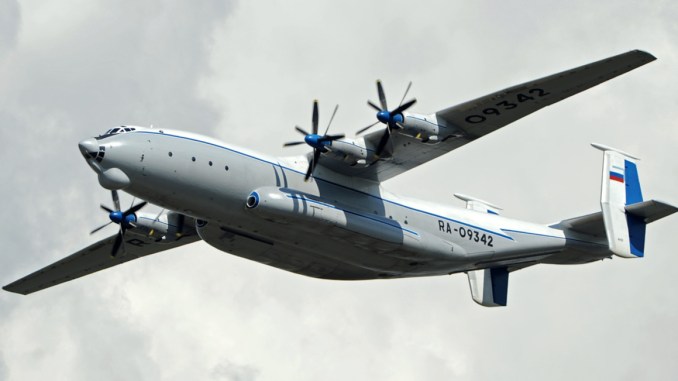
A follow-on of the An-12, it was first unveiled internationally in the Paris Air Show in 1965
The world’s largest turboprop aircraft, the Antonov An-22 “Antei” will be retired from service of the RuAF (Russian Aerospace Forces). This is according to the commander of its Military Aviation Administration, Lieutenant General Vladimir Benediktov, who revealed the decision on Soloviev Live. He said the plane’s “operation will cease in 2024.”
The An-22, (NATO reporting name “Cock”) developed during the time of the Soviet Union, is a high-wing, ‘h-tail’ configuration aircraft powered by four turboprop engines, each turning two contra-rotating propellers. It has a circular/tubular main fuselage, with massive landing gear bulges on both sides.
Both features are prominently visible when looked at from the front. It has a capacity of around 80-tons and fly for 5,000-km with full payload at 29,000-feet. Other Russian sources say it has a payload capacity of 60-tons.
Benediktov added that a total of 67 An-22 aircraft were produced, some remained in Ukraine, and there were about 60 aircraft in the Russia’s Military Transport Aviation Command fleet. Open source Russian aviation registries show a majority of them being “cut” from service, with five “in storage”, four still flying and six lost to “catastrophes and accidents.”
Construction of the prototype was completed by Jan. 1964, and undertook its first flight in Feb. 27, 1965 – just 5 years after the project began. Within three months after that, it was unveiled internationally for the first time at the Paris Air Show. Upon returning, the An-22 resumed testing and entered serial production in November.
Massive Plane for Massive Cargo
Following the collapse of the USSR in 1991, Antonov became a Ukrainian concern, but with significant commercial interests in Russia. However the war since Feb. 2022 and the subsequent Western sanctions made pre-existing aerospace business ties between the two countries unviable. This made it difficult for Russia to repair and maintain many of the Antonov planes in its civilian and military fleet.
Described as the “largest” turboprop aircraft in the world, the wide-body plane was designed to carry massive loads like ballistic missiles, possibly between sites. At the time, the Soviet army wanted an aircraft that could carry the new 36-ton T-54 tank, along with its crew and supplies.
Another An-22 of the Russian Aerospace Forces. (Image credit: Wikimedia Commons)
” data-medium-file=”https://i0.wp.com/theaviationist.com/wp-content/uploads/2024/06/An22-2.jpg?fit=460%2C259&ssl=1″ data-large-file=”https://i0.wp.com/theaviationist.com/wp-content/uploads/2024/06/An22-2.jpg?fit=706%2C397&ssl=1″ class=”size-large wp-image-86707″ src=”https://zephyrnet.com/wp-content/uploads/2024/06/russia-to-retire-its-fleet-of-the-worlds-largest-turboprop-aircraft-the-antonov-an-22-antei-1.jpg” alt width=”706″ height=”397″ srcset=”https://zephyrnet.com/wp-content/uploads/2024/06/russia-to-retire-its-fleet-of-the-worlds-largest-turboprop-aircraft-the-antonov-an-22-antei-1.jpg 706w, https://zephyrnet.com/wp-content/uploads/2024/06/russia-to-retire-its-fleet-of-the-worlds-largest-turboprop-aircraft-the-antonov-an-22-antei-2.jpg 460w, https://zephyrnet.com/wp-content/uploads/2024/06/russia-to-retire-its-fleet-of-the-worlds-largest-turboprop-aircraft-the-antonov-an-22-antei-3.jpg 128w, https://zephyrnet.com/wp-content/uploads/2024/06/russia-to-retire-its-fleet-of-the-worlds-largest-turboprop-aircraft-the-antonov-an-22-antei-4.jpg 768w, https://zephyrnet.com/wp-content/uploads/2024/06/russia-to-retire-its-fleet-of-the-worlds-largest-turboprop-aircraft-the-antonov-an-22-antei-5.jpg 678w, https://i0.wp.com/theaviationist.com/wp-content/uploads/2024/06/An22-2.jpg?w=1198&ssl=1 1198w” sizes=”(max-width: 706px) 100vw, 706px” data-recalc-dims=”1″>
It was developed in the 1960s, as a follow-on of the An-12, where Moscow wanted an even larger aircraft with a heavier payload. It is powered by the same monstrous NK-12MA turboprop engines that fly the Tupolev Tu-114 and the Tu-95. Particularly, Soviet Airborne Forces wanted to be able to transport their new BMD-1 series of armored fighting vehicles. The An-22 could carry four BMD-1s to only one in the An-12.
The heavy cargo carrying capacity also had civilian applications. Ferrying heavy goods across long distances in remote locations with unprepared airstrips that needed stronger landing gears has always been in the need in Russia, especially in regions like Siberia. This cargo included machinery, industrial components, tractors and other field equipment.
TASS quoted open sources, saying the aircraft saw its share of accidents, with nine planes of the type lost in seven mishaps where 102 persons were killed. A major accident involving the An-22 in Russia took place on Dec. 28, 2010. The aircraft of the type, with the registration number RA-09343, crashed “during training” in Russia’s central Tula region, killing 12 onboard.
The plane, that took off from Voronezh and was heading to Migalovo airport in Tver, reportedly experienced an “electrical failure.” Officials said it simply “vanished” off the radar screens.
Variants
Two major variants developed, one of which was the standard An-22A. This had an ‘air start’ capability, with improved electrical, radio communications and navigation equipment. The An-22P3 meanwhile was designed for transporting the center wing sections and outer wings of the An-124 and An-225 aircraft, externally, above the fuselage.
Other planned versions included those serving amphibious, search and rescue roles but did not progress past the scale model phase. An ambitious project was when the Soviets fitted the An-22 with a nuclear power plant as an ASW (Anti-Submarine Warfare) aircraft. In 1972, that prototype made 23 test flights under the ‘Stork’ program, after which the reactor was dismantled. The An-22PLO was then altogether shelved in the mid-1970s.
- SEO Powered Content & PR Distribution. Get Amplified Today.
- PlatoData.Network Vertical Generative Ai. Empower Yourself. Access Here.
- PlatoAiStream. Web3 Intelligence. Knowledge Amplified. Access Here.
- PlatoESG. Carbon, CleanTech, Energy, Environment, Solar, Waste Management. Access Here.
- PlatoHealth. Biotech and Clinical Trials Intelligence. Access Here.
- Source: https://theaviationist.com/2024/06/06/russia-to-retire-the-an-22/




